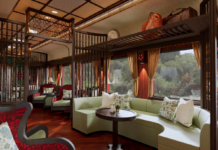The recent decision to implement a ban on large buses in Hanoi’s Old Quarter is a bold move towards improving congestion and the overall visitor experience. This is just one part of a carefully planned strategy to revolutionize how people navigate and engage with this culturally rich district, a true historical gem of the capital city.
Hanoi is actively pursuing a range of initiatives to modernize public transportation, enhance tourism management, and preserve its heritage. The ultimate goal is to create an environment that is more accessible, sustainable, and enjoyable for both locals and visitors alike.
 |
| The centuries-old houses of Hanoi’s Old Quarter remain inhabited, creating a unique blend of history and modern life. Photo: Hoang Bao/ Kinh te & Do thi Newspaper |
For too long, the Old Quarter has been plagued by traffic jams, with its narrow streets choked by vehicles, especially large tourist buses. This has caused significant disruptions to local businesses and the daily lives of residents. By reducing the number of cars and improving travel efficiency, the new bus restriction aims to address these issues.
Dao Thi Tho, a long-time resident, shared her experiences with VTV24, highlighting how large tourist buses obstruct traffic and impact their daily lives, especially during peak hours. International tourist, Travis, also expressed concerns about the lack of organized drop-off points, suggesting that designated stations outside the Old Quarter could be a reasonable solution.
Recognizing the importance of maintaining accessibility, the authorities have taken proactive steps beyond the vehicle ban. One notable effort is the construction of Metro Line 2, providing a direct link between Noi Bai International Airport and downtown Hanoi. This will drastically reduce the need for private transfers and large shuttle buses, making it easier for international visitors to reach the heart of the city.
Hanoi has also expanded its electric bus network, introducing eco-friendly routes connecting the Old Quarter with surrounding areas. These clean energy buses support the city’s green initiatives and provide an efficient travel option for those wanting to explore without adding to congestion. The introduction of designated transfer points will further enhance the convenience of visitors, easing traffic flow and creating a more pedestrian-friendly urban environment.
The rethinking of traffic management goes beyond vehicle reduction. Officials have redesigned key intersections and adjusted traffic patterns, installing new signage and rerouting lanes to ensure smoother flow for smaller vehicles, bicycles, and pedestrians. These changes reinforce a people-centered approach to mobility in the district.
In tandem with infrastructure upgrades, Hanoi has also focused on improving tourism services. Hoan Kiem District, in particular, has launched hospitality training programs for local business owners, street vendors, and tour operators, covering customer service, professional behavior, and cultural etiquette. These programs aim to address longstanding issues and create a more welcoming and polished tourist experience.
From a business perspective, Nguyen Van Hien, CEO of Asia Impression Travel, acknowledged the need to adapt to these changes, stating that his company is reorganizing its logistics and coordinating with partners to ensure a smooth transition. Hanoi has also introduced digital and interactive experiences, such as heritage tours by electric vehicle and virtual reality exhibitions, offering immersive storytelling experiences that reduce the environmental impact of mass tourism.
The expansion of pedestrian zones, including the successful weekend pedestrian streets around Hoan Kiem Lake, has provided a much-needed car-free environment, attracting both locals and tourists. Hanoi continues to refine these areas, balancing commercial opportunities with historical preservation.
The cultural programming has also been enhanced, with an increased number of heritage festivals, art exhibitions, and community-driven initiatives. This ensures that tourism growth is rooted in meaningful engagement, creating a unique atmosphere that sets Hanoi apart. As these projects progress, the Old Quarter is evolving into a more pedestrian-friendly, environmentally conscious, and culturally vibrant destination, signaling a long-term commitment to its treasured past and future prosperity.
Le Anh Thu, Vice Chairman of the Hoan Kiem District People’s Committee, emphasized that the district is renowned not only for its architecture and historical sites but also for its rich intangible cultural heritage, particularly its diverse and refined culinary traditions, which evoke a deep sense of nostalgia for many.
Hanoi’s Historic Crafting Communities Join the World Crafts Network
The villages of Bat Trang and Van Phuc are vibrant hubs of creativity, where the ancient traditions of Vietnamese craftsmanship are kept alive by skilled artisans. These masters of their trade showcase a dedication to their art, producing exquisite creations that reflect a rich cultural heritage. It is a place where the past meets the present, and the skills of traditional craftsmen continue to thrive and inspire.
“Dutch Embassy Staff Don ‘Ao Dai,’ Bringing Color to Hanoi’s Ta Hien Street”
Hoping to capture the essence of Tet and create lasting memories of the Lunar New Year celebrations, the Dutch Ambassador to Vietnam, Kees van Baar, and his fellow embassy members in Hanoi, donned the elegant ao dai, Vietnam’s traditional costume. The group chose the vibrant Ta Hien Street as their backdrop for a unique and colorful photoshoot, a perfect fusion of Dutch and Vietnamese culture.








